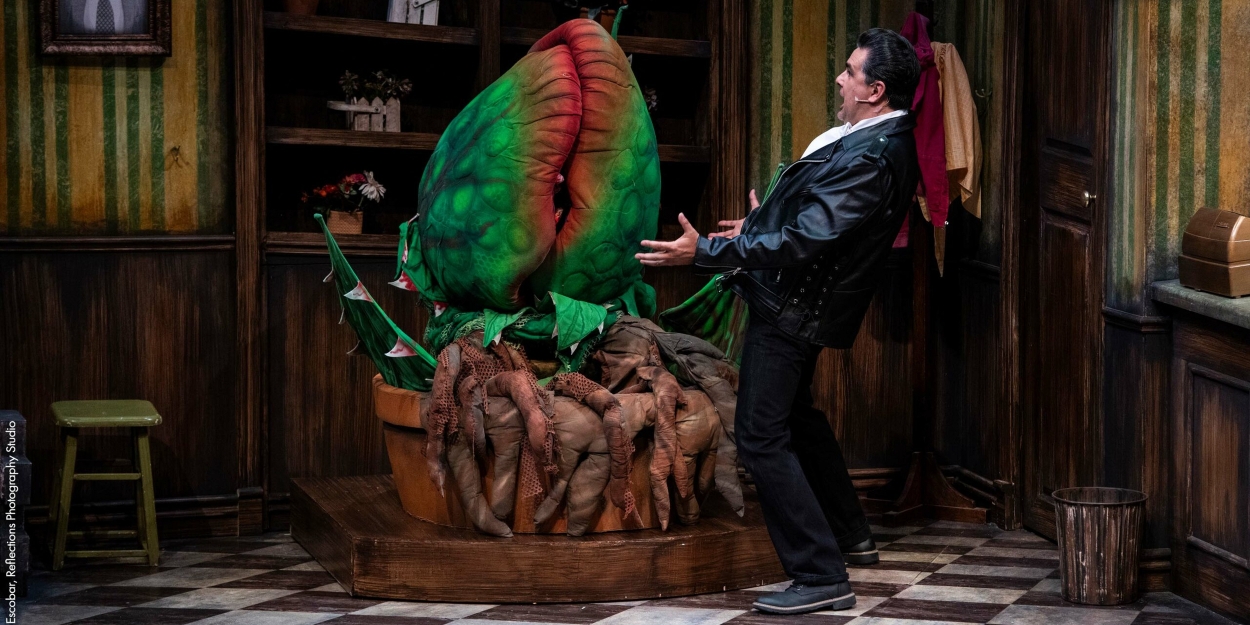Review: LITTLE SHOP OF HORRORS at PCPA: Solvang Festival Theater
PCPA cultivates new blooms from the classic musical “Little Shop of Horrors”

"Little Shop of Horrors'" director/choreographer Keenan Hooks blends camp sensibilities with emotional honesty in his staging of this musical. The theatricality of the puppeteering in this send-up of B-horror flicks like “The Day of the Triffids” or “It Came from Outer Space” and 1960s pop tunes make it worth the price of admission.
For all the “horror” of the plot, the musical offers a campy juxtaposition of innocence and menace. During the prologue’s foreboding narration, for example, several down-on-their-luck Skid Row bums stumble through the scene, crawling on stage from the pit, setting up what could be a sci-fi tale of urban alienation. Soon, however, three very posh-looking, spangle-clad, sparkling women come in singing an upbeat tune, “Little Shop of Horrors.”
These characters: Ronnette (Brezae Weeks), Chiffon (Etasha Caston), and Crystal (Marisa Moenho), personify the main characters’ aspirations for worry-free luxury and freedom from endless drudgery. Eye and ear-catching throughout, the vocal trio comments on the story and the questionable choices made by our hero, Seymour Krelborn (Alexander Pimentel), just like a Greek Chorus.
Set designer Joe C. Klug’s rendering of Skid Row provides perfect potting soil for the story to grow. He has opened the titular flower shop to our unobstructed view. Within the shop, all the planar surfaces are askew. The potted plants and flower shop objects defy gravity resting on the shelves, which are all akimbo. The scenery holds us in suspense. Everything here is about to crash.
Behind the shop, the world looks equally non-sensical; the urban skyline is composed of sharp zigging and zagging lines, not unlike Disneyland’s Toontown if you honed all its edges with a file. This town looks like it wants to prick you and then you’d bleed cartoon blood.
Here we find our hero, Seymour Krelborn, who was taken in as a youngster by shop owner Mr. Mushnik (Central Coast favorite, Billy Breed) and kept around as a source of free labor rather than out of affection. Seymour is hopelessly besotted with his co-worker Audrey (Molly Dobbs), who already has a boyfriend, a sadistic dentist (George Walker who plays several roles to comic effect). The fact that composer Alan Menken’s father was a “boogie-woogie piano-playing dentist,” combined with the themes of parental abandonment in the story... It makes you think.
Seymour’s one asset, the never-seen-before plant he’s cultivated, could give him all his heart desires: his beloved Audry, fortune, fame, and even family.
The voice of "The Plant," (Diva LaMarr) is presented in the show as a drag queen, another campy note mixed in with the story’s horrors. LaMarr’s vocal range includes high pitches that capture the innocence of The Plant as a small seedling and later reveal the deeper registers of the growing plant’s strange appetite.
“Audry Two,” as Seymour has named his beloved plant, grows large before our eyes. The stagecraft behind animating The Plant mesmerizes the audience. The puppetry, as performed by Michael Gould and Andrew Missael Banderas, has the “how do they do that” appeal of a magic act. The 1986 movie version of the musical starring Rick Moranis cannot match the storytelling power of this live theater experience. Watching The Plant as it advances its evil plans in Act Two, moving its grotesque plant arms while Diva LaMarr matches its emotional tone with their voice is thrilling.
The inventiveness of the puppeteering makes the play worthy of an extended evening in Solvang, rounded out by solid performances and a captivating story.
Reader Reviews

Videos

